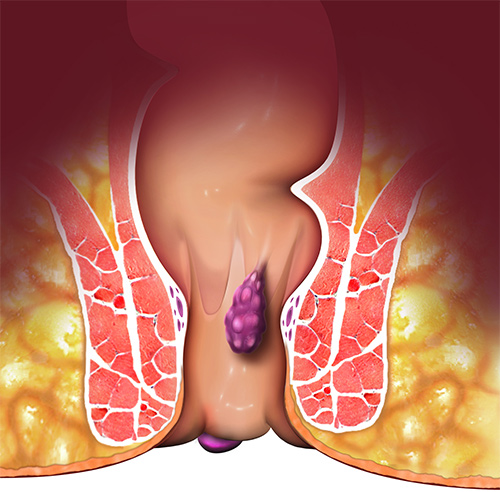Haemorrhoids
Haemorrhoids or piles are swollen veins in lower rectum or anus.
Types of Haemorrhoids
Haemorrhoids may be external or internal. If they develop inside the rectum, they are called internal haemorrhoids. External haemorrhoids develop around the anus just below the skin. Some of the external haemorrhoids develop blood clots and are quite painful. They are called thrombosed haemorrhoids. Another type of piles is so large that they often protrude during defaecation. They are called prolapsing piles.

What Causes Haemorrhoids?
The exact cause of haemorrhoids is unknown. Possible causes include:
- Pregnancy and childbirth
- Prolonged straining to pass stools (If you suffer constipation)
- Obesity
- Diet low in fibre
- Chronic diarrhoea
- Anal intercourse
Symptoms of Haemorrhoids
The symptoms of haemorrhoids include:
- Pain and discomfort
- Pain may increase during defaecation
- Bleeding, which is commonly observed during defaecation
- Itching or irritation to the anal area
- Lumps outside the anus which may or may not be painful
- Your anal area may be swollen
Diagnosis of Haemorrhoids
The presence of haemorrhoids is diagnosed by your doctor digitally with a gloved finger. Your doctor may use an anoscope, sigmoidoscopy or a proctoscope to check for internal piles.
Treatment of Haemorrhoids
Haemorrhoids are never life-threatening. The symptoms of bowel cancer may be like haemorrhoid symptoms. Therefore, it is important to be properly diagnosed.
Most haemorrhoids are treated by non-surgical methods. Minimally-invasive procedures are found to be effective in many patients. Surgery may be needed in extreme cases.
Non-surgical Methods
- Your doctor prescribes medications to reduce pain, itching, and inflammation. It may be in the form of tablets or ointments.
- You must consume a high-fibre diet. Avoid straining during defaecation.
- Keep the anal area clean. Use cold packs to reduce inflammation. Take a sitz bath.
- Your doctor may remove a painful clot by simple incision.
Minimally-Invasive Methods
Sclerotherapy: Your doctor injects certain chemicals to cause shrinkage of the haemorrhoids.
Rubber band ligation: The base of the haemorrhoids is tied with small rubber bands. This cuts blood circulation and the haemorrhoids fall off. There may be certain complications associated with this technique.
Coagulation technique: It involves hardening of the haemorrhoid with radiation or heat increases the chances of haemorrhoid falling off.
Surgery
Haemorrhoidectomy: The haemorrhoids are surgically removed. It is performed under general anaesthesia or with local anaesthesia. Pain and difficulty in defaecation after surgery for a few days are some of the complications of the surgery.
Haemorrhoid Stapling: It is a surgical method to block blood flow to the haemorrhoids. This technique has various complications such as recurrence of the haemorrhoids.
Prevention of Haemorrhoids
Follow these simple lifestyle and diet habits to avoid the occurrence of haemorrhoids.
- Eat a high fibre diet. Do not consume foods such as chips, ice creams, fast food, frozen food, processed food, red meat, etc which may increase chances of constipation and haemorrhoids.
- Stay physically active. Exercise maintains gastrointestinal health.
- If you are obese, plan a weight loss program.
- If you are suffering from inflammatory bowel disease, properly manage it.